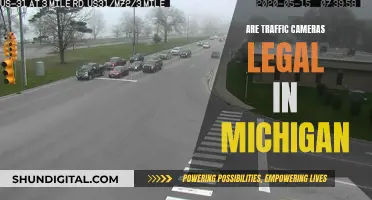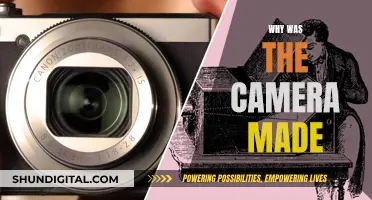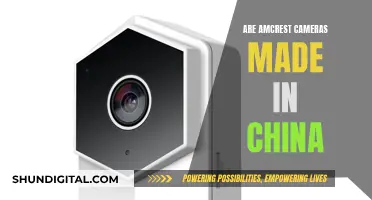
Traffic control cameras are an essential part of a city's public infrastructure. They are video cameras that monitor and observe traffic flow and congestion on roads and highways. These cameras are typically mounted on poles, bridges, or traffic light poles at intersections and are connected to a control centre where the footage can be viewed in real-time. They are distinct from road safety cameras, which are installed to enforce road rules by taking still photos. Traffic control cameras are used to improve traffic flow and safety, and some are equipped with sensors to detect the speed of vehicles and issue tickets to those who are speeding.
| Characteristics | Values |
|---|---|
| Purpose | To monitor and enforce road safety, detect and prevent traffic violations, and improve traffic flow and safety |
| Installation | Mounted on poles, bridges, traffic light poles, gantries, or other structures; can be fixed, portable, or mobile |
| Technology | May use radar, laser, infrared, or optical character recognition (OCR); some have AI capabilities |
| Data Storage | May be connected to a control center or network for real-time monitoring; some have local storage with encryption |
| Speed Measurement | Capable of measuring speed and detecting speed violations |
| Vehicle Identification | Can identify vehicles through license plate recognition (LPR) or automatic number plate recognition (ANPR) |
| Detection of Traffic Violations | Can detect violations such as running red lights, speeding, not using seat belts, and unauthorized use of lanes |
| Incident Response | Provide early warning of accidents or disruptions, allowing for quicker response from authorities |
| Data Gathering | Collect traffic data to improve road planning, congestion management, and traffic flow |
What You'll Learn

Traffic control cameras improve road safety
Traffic control cameras are an essential component of road safety, offering numerous benefits that improve safety for motorists, pedestrians, and passengers alike. These cameras are strategically placed in various locations, including complex intersections, congested roads, and areas with extreme weather conditions. By providing real-time surveillance and data collection, traffic control cameras enhance safety, facilitate efficient traffic flow, and enable prompt incident responses.
One of the primary advantages of traffic control cameras is their ability to reduce accidents and enhance road safety. Mounted on poles, bridges, or other structures, these cameras offer a comprehensive view of traffic flow, enabling authorities to monitor and manage traffic effectively. This surveillance helps identify accidents or disruptions and take appropriate action, reducing the likelihood of collisions and ensuring the safety of all road users.
Traffic control cameras also play a crucial role in enforcing traffic laws and regulations. Equipped with sensors, these cameras can detect vehicles' speed, enabling authorities to identify speeding violations and issue tickets to offenders. Additionally, cameras installed at intersections, known as red-light cameras, capture images of vehicles running red lights, providing evidence for potential traffic violations and deterring such behaviour. This automated enforcement improves road safety by reducing the number of accidents caused by red-light running.
Another significant benefit of traffic control cameras is their ability to facilitate smooth traffic flow and prevent traffic congestion. By collecting real-time traffic data, these cameras help authorities make informed decisions to optimize traffic management. They can also be integrated with other systems, such as parking lot surveillance cameras, to develop robust strategies that alleviate congestion and improve overall traffic flow.
Furthermore, traffic control cameras provide valuable data for city planning and transportation management. The data collected by these cameras enables authorities to identify traffic patterns, pinpoint congestion triggers, and make informed decisions when designing new road projects or implementing traffic management strategies. This data-driven approach contributes to more efficient and safer roads for everyone.
While some may raise privacy concerns, it is important to note that traffic control cameras are primarily used for safety and traffic management purposes. The use of these cameras has led to a significant reduction in personal injury collisions and the number of people killed or seriously injured on our roads. By deterring traffic violations, improving traffic flow, and providing critical data for road planning, traffic control cameras play a vital role in enhancing road safety and saving lives.
The Best Rear Camera Placement for Your Car
You may want to see also

They can be used to enforce traffic laws
Traffic control cameras are an essential part of cities' transportation and logistics departments, working to improve traffic flow and safety. They are placed strategically in various locations such as complex intersections, roads with traffic congestion, or areas that frequently experience extreme weather. These cameras are typically mounted on poles, bridges, or other structures and are usually placed at intersections, on-ramps, and other points where traffic is likely to be heavy or congested.
Traffic control cameras can be used to enforce traffic laws. They can monitor and manage traffic at busy crossings and detect vehicles approaching and moving through intersections using sensors. They can also enforce red-light violations by capturing images of vehicles that run red lights, which can then be used to issue tickets. Additionally, these cameras collect traffic data to help improve road safety and traffic flow.
Red light cameras are specifically designed to capture images of vehicles that run red lights at intersections. These cameras are typically activated when a vehicle passes over a sensor in the roadway as the traffic signal is red. The camera will then capture images of the vehicle and its license plate, which can be used to identify the driver and issue a ticket. Red light cameras are typically mounted on poles or other structures near the intersection and are used to enforce traffic laws and improve safety at intersections.
Speed cameras are another type of traffic control camera that can be used to enforce traffic laws. These cameras are used to monitor compliance with speed limits and can be fixed or mobile. Fixed speed cameras are stationary cameras that are mounted on poles or other structures and are used to monitor traffic at a specific location, such as school zones or near intersections. Mobile speed cameras are portable cameras that can be moved from one location to another and are typically mounted on vehicles, such as police cars. Both types of speed cameras use sensors to detect the speed of passing vehicles and can capture images of those that are speeding, which can then be used to issue tickets.
In addition to red light and speed cameras, there are also bus lane enforcement cameras and noise enforcement cameras. Bus lane cameras detect vehicles that are illegally using bus lanes, while noise cameras monitor and enforce compliance with local or national vehicle noise limits. All of these types of traffic control cameras can play a crucial role in enforcing traffic laws and improving road safety.
Hacking Risks: Webcam Security and Privacy Concerns
You may want to see also

They can be used to monitor traffic flow
Traffic control cameras are an essential component of a city's transportation and logistics departments, and they play a crucial role in improving traffic flow and road safety. These cameras are strategically placed at complex intersections, congested roads, or areas with extreme weather conditions.
Traffic control cameras are typically mounted on poles, bridges, or other structures, providing a comprehensive view of traffic flow and conditions. They are connected to a control centre or network, allowing traffic engineers and law enforcement personnel to monitor traffic flow in real time. This enables them to detect accidents, congestion, or other disruptions and take prompt action.
For instance, if a traffic monitoring camera detects a vehicle pulled over, it can immediately alert transportation officials. They can then assess the situation and decide to send emergency services or redirect traffic to prevent further congestion. These cameras also help in enforcing traffic laws, as some are equipped with sensors that detect speeding vehicles, allowing authorities to issue tickets.
In addition to improving traffic flow, these cameras aid in city planning and data gathering. The recorded footage helps authorities understand traffic patterns and make informed decisions when developing new traffic management strategies and road projects. Furthermore, the real-time footage assists news organisations and the public in planning their routes by providing up-to-date traffic information.
Overall, traffic control cameras are a valuable tool for monitoring and improving traffic flow, ensuring road safety, and enhancing the efficiency of transportation systems.
Unveiling Surveillance Cameras: Components and Inner Workings
You may want to see also

They can be used to detect traffic violations
Traffic control cameras are an essential part of a city's transportation and logistics departments, working to improve traffic flow and safety. These cameras are strategically placed in various locations such as complex intersections, roads with heavy congestion, or areas that frequently experience extreme weather. They are typically mounted on poles, bridges, or other structures, and are connected to a control centre or network where traffic engineers or law enforcement personnel can view the images in real time.
Traffic control cameras can be used to detect traffic violations such as speeding, running red lights, or unauthorised use of bus lanes. For example, red-light cameras are activated when a vehicle passes over a sensor in the roadway during a red signal, capturing images of the vehicle and its license plate to issue a ticket. Similarly, bus lane enforcement cameras use sensors in the road to detect unauthorised vehicles.
Another type of traffic camera is the speed camera, which uses sensors to detect the speed of passing vehicles and can capture images of those speeding. These cameras are typically placed in areas with a history of speeding, such as school zones or near intersections. Mobile speed cameras are also used, which can be mounted on vehicles like police cars and moved to different locations.
In addition to detecting traffic violations, traffic control cameras offer other benefits such as improved incident response, reduced traffic accidents, and enhanced data gathering for better city planning. The presence of these cameras can also act as a deterrent, encouraging drivers to follow traffic rules and speed limits, thereby improving road safety.
Firm Fix: Repairing Loose Camera Battery Compartments
You may want to see also

They can be used to prevent traffic congestion
Traffic control cameras are an essential part of cities' transportation and logistics departments, working hard to improve traffic flow and safety. They are placed strategically in various locations such as complex intersections, roads with traffic congestion, or areas that frequently experience extreme weather.
Traffic monitoring cameras are typically deployed at strategic locations along roads and highways to provide a comprehensive view of traffic flow and conditions. These cameras may be mounted on poles, bridges, or other structures and are usually placed at intersections, on-ramps, and other points where traffic is likely to be heavy or congested.
Once deployed, the cameras are connected to a control center or network, where the images they capture can be viewed in real time by traffic engineers or law enforcement personnel. These individuals can use the images from the traffic monitoring cameras to monitor traffic flow, detect accidents or other disruptions, and take appropriate action if necessary.
Traffic monitoring systems can be used with other systems like parking lot surveillance cameras for a more robust security strategy for street safety. Some traffic monitoring cameras are equipped with sensors that can detect the speed of vehicles, allowing authorities to enforce traffic laws and issue tickets to drivers who are speeding.
Traffic control cameras can be used to prevent traffic congestion by monitoring traffic flow and conditions in real time. This information can be used to adjust traffic signals, reroute traffic, or take other actions to optimize flow and reduce congestion. For example, if a traffic monitoring camera detects heavy traffic in one area, the control center can reroute traffic to alternative routes to relieve congestion.
In addition, traffic control cameras can also be used to enforce traffic laws, such as red-light running and speeding, which can help to reduce traffic congestion. For instance, a red-light camera can capture images of vehicles that enter an intersection during a red light, and this information can be used to issue citations and deter future violations. Speed cameras can also help to enforce speed limits and reduce traffic congestion by capturing images of speeding vehicles.
Furthermore, traffic control cameras can be used to collect data on traffic patterns and behaviour, which can be analysed to identify congestion hotspots and develop strategies to mitigate them. This data can inform decisions on traffic management strategies and new road projects, helping to prevent congestion before it occurs.
By utilising traffic control cameras, cities can improve traffic flow, enforce traffic regulations, and optimise transportation systems to prevent traffic congestion and enhance overall road safety.
Traffic Cameras in Culver City: Are They Legal?
You may want to see also
Frequently asked questions
A traffic control camera is a video camera that observes traffic on roads, usually placed at strategic locations such as intersections, roads with congestion, or areas with extreme weather.
Traffic control cameras are typically mounted on poles, bridges, or traffic light poles, and connected to a control centre. They capture real-time video footage, which can be monitored by traffic engineers or law enforcement personnel to detect accidents or disruptions and take appropriate action.
Traffic control cameras can help reduce accidents, improve traffic flow and safety, and provide valuable data for city planning and traffic management. They also assist in enforcing traffic laws, such as detecting red-light violations and speeding.
Yes, there are several types, including red light cameras, speed cameras, and traffic surveillance cameras. Red light cameras capture images of vehicles running red lights, while speed cameras detect vehicles exceeding the speed limit. Traffic surveillance cameras monitor traffic flow and conditions more generally.
Yes, the use of traffic control cameras has raised concerns about loss of privacy and the potential for mass surveillance of vehicle movements. However, in some cases, courts have found that human rights are not being breached by the use of these cameras.







